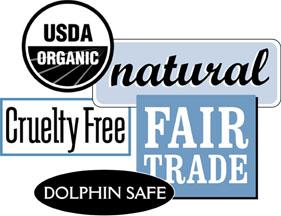Eco-Labels: Truth or Consequences

For the last several years we have been hearing about what has recently become the most recognized "eco-label" on Mother Earth: "Organic." In our stores, however, we see numerous other eco-labels designed to communicate information to consumers, differentiate a product from others that are similar, and/or establish a brand identity. Most eco-labels are created with the hopes of gaining product premiums.
It is easy to find eco-labels on products in retail stores today that offer product information that today’s consumers have determined important. Examples include: "Environmentally Sound/Friendly…", "Cruelty Free," "Humane Treatment of Animals," "Dolphin Safe," "Fair Trade," and Agricultural claims (i.e. "USDA Organic" or "IPM-certified"). But what do they really mean, and how are these labels created?
Definitions
In order to understand how to create and legally use an "eco-label," we must first understand a few terms. Eco-labels are general claims, sometimes verified and sometimes not. They may or may not be regulated. In every case, truth in labeling laws apply, as do all basic labeling laws regarding information placement and use of terms.
General claim: Claims used on products that are not independently verified are general claims; they are often placed on the product by the manufacturer.
Logo or seal: An identifying mark that is affixed to a product or item, a logo or seal is usually trademarked and indicates association with or approval by the owner of the mark.
Certifier: A certifier evaluates a company wishing to put a particular label on its products and verifies that the products conform to the standards behind the label.
Accreditor: An accreditor develops a set of standards behind a label and then authorizes or accredits a certifying organization to verify that any company using the label on its products is following standards.
Brand: A brand is a printed mark made to attest to manufacture or quality or to designate ownership
Label: A label is a display of written, printed, or graphic material on the immediate container of an agricultural product or any such material affixed to any agricultural product or affixed to a bulk container containing an agricultural product, except for package liners or a display of written, printed, or graphic material that contains only information about the weight of the product.
General claims and verification
There is no organization behind the claim "natural" other than the company manufacturing or marketing the product. The USDA has defined the use of the term and can hold manufacturers accountable to the proper use of the claim but does not have a verification system in place. There is currently no standard definition for this term except on meat and poultry products as defined by the U.S. Department of Agriculture. Meat and poultry carrying the "natural" claim must not contain any artificial flavoring, color ingredients, chemical preservatives, or artificial or synthetic ingredients, and are only "minimally processed" defined by USDA as a process that does not fundamentally alter the raw product. The use of the term "organic," as well as other eco-labels used on meat products is regulated by the Federal Safety Inspection Service (FSIS: www.fsis.usda.gov).
Most general claims on labels are not regulated at all, but they may be verified in one of the following ways:
First-party labels are issued by the manufacturer without independent review and are also called "self-certified" labels.
Industry, trade or membership associations issue second-party labels. The standards may be developed by the second party organization but certified or verified by an independent or third party organization.
Third-party labels are issued by organizations that are truly removed from the product that they certify and the manufacturers and retailers of the product. The decision-makers within these organizations (such as the board of directors) do not have any direct ties to the certified industry. USDA’s organic regulation requires certifiers to demonstrate no conflict of interest.
What makes a good eco-label for consumers?
Consumers look to eco-labels to provide them with product information. Any such label should be meaningful and verifiable, consistent and clear, transparent, independently issued, and provide for public comment.
Is an eco-label right for you?
Retailers may consider designing a brand name and/or eco-label of their own. Before doing so, some items to consider are:
- Does it have a real meaning for consumers?
- Is it legal?
- Is there a verification program for the claim?
- Does your eco-label effectively represent you and your products?
- Does it improve your bottom line?
Label integrity and protecting yourself
Beware of:
- verification programs that lack competence, freedom from conflict of interest, and transparency–ask questions!
- labeling programs that only benefit others at your expense–where does the money go?
- infringing on someone else’s trademarked or copyrighted label–do the research!
- violating regulations–make sure to comply with any laws or requirements!
- not being able to demonstrate that your product is labeled truthfully–protect yourself from potential "label fraud"–keep records to prove you do what you say you do!
For more information on eco-labels
Visit: http://www.eco-label.org. This site, developed by Consumers Union, provides basic information, definitions of eco-labels, regulations, contacts, and "report cards" on various labels and organizations who use these labels.
Information on one eco-label now on the market, launched in association with the American Humane Association, may be found at www.freefarmed.org.
Cissy Bowman and Juli Brussell will be giving a presentation on eco-labels at the Upper Midwest Organic Farming Conference February 28, 2003. For more information visit: www.mosesorganic.org.
Cissy Bowman manages Hoosier Organic Marketing Education, a non-profit educational organization: 8364 S. SR 39, Clayton, IN 46118; 317/539-4317; or [email protected].
Juli Brussell is marketing project coordinator for Illinois Stewardship project ([email protected]).







